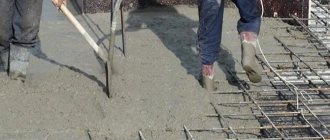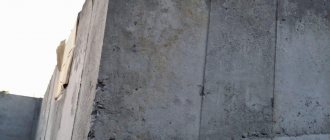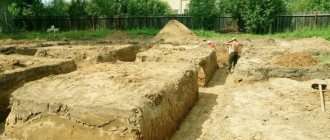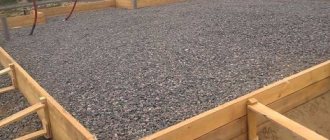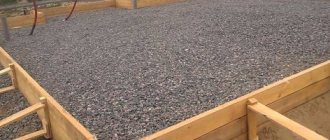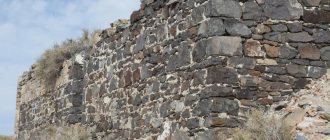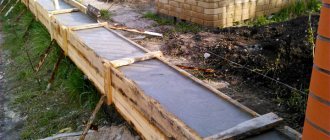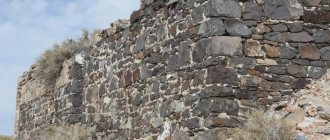The biggest problem and at the same time a headache for constructing a foundation is the geological structure of the soil on the construction site.
Preparing the foundation for a foundation on weak peat soils can consume half the budget allocated for the arrangement of the entire foundation system. A competent analysis of the geology and bearing capacity of the soil makes it possible to avoid serious problems, but even with positive results, experienced builders carefully prepare the base for the foundation, remove weak soil and prepare the cushion, without skimping on materials and volume of work. Moreover, the work done and the results obtained are necessarily recorded in the act of acceptance of the base for the foundations.
Proper preparation of the base for the foundation
Any professional builder knows that the first half meter of soil has the lowest load-bearing capacity and is often not taken into account when designing foundations. To obtain the most stable and reliable position of the building box, it is necessary to get to the most stable and dense layers of rock, the condition of which and bearing capacity do not depend on air temperature and amount of precipitation. Therefore, preparing the base for the arrangement of the foundation requires a significant and materially costly amount of work:
- Planning the site of the future foundation, removing surface soil, and in the case of thick deposits of peat, loam, and water-logged clays, during preparation it is necessary to remove the surface layer by a meter or more; Arrangement of drainage systems with planning of future drainage slopes and storm drainage; Compaction of soil with vibratory rollers, backfilling of pillows from crushed stone, sand; If necessary, laying concrete preparation under the base of the foundation and waterproofing.
The completed acceptance document, protocol or act confirms the scope of work completed, the thickness of the laid crushed stone and sand, the presence of a geotextile base, but does not reflect the quality of the sand, which plays a major role in ensuring the bearing capacity of the foundation base.
To ensure the necessary strength of the surface layer of the rock, the soil is prepared, compacted and filled with crushed stone of different fractions, first coarse, then screenings and, finally, sand. A layer of crushed stone sealed into the ground dramatically increases the stability of the foundation, but due to its high rigidity and hardness, it is not able to evenly transfer the load from the weight of the building to the base of the foundation and to the surface of the earthen layer.
Performing crushed stone preparation
The use of prepared foundations based on crushed stone allows you to reduce the costs of construction activities. After all, cement is saved, and the cost of purchasing crushed stone is quite acceptable. Crushed stone preparation for the foundation is permitted by the set of rules and building codes. In this case, the layer thickness should be about 20 centimeters. The crushed stone layer must be thoroughly compacted and filled with liquid bitumen. Filling the bitumen solution is carried out if it is necessary to saturate the soil as much as possible or to form a waterproofing bitumen film.
This method does not provide high rigidity of the substrate and makes it difficult to carry out foundation measures. It is widely used for low-impact construction of technical facilities, utility rooms and auxiliary buildings.
Functions of sand filling
Sand plays the role of glue and elastic cushion, which allows you to compensate and distribute all forces, including when the soil swells or the foundation settles.
The sand material used in preparing and filling the base must meet certain requirements and criteria:
- Gravel sand is considered the best, very coarse and clean; fills made from such material have the lowest specific gravity, but at the same time easily allow water to pass through; Minimum amount of inclusions of clay, earth, lime and salt contaminants; Sand should not contain any forms of organic matter, silt, peat, plant remains - everything that natural bodies of water are rich in. When such material is used in preparing the base, after a certain period of time the sand cushion turns into a dense waterproof layer of mud, saturated with organic decomposition products.
Tip! The quality of sand can be easily checked using available tools. For example, if you pour 5-6 liters of water into a hole dug in the ground, covered with sand, then if the quality is good, the water will go away in a few minutes; in dirty sand, a puddle will remain on the surface.
Application of profile membranes
Collections of building codes and regulations when preparing foundations provide for the use of modern technological solutions, which include profile-type membranes. Their use simplifies the process of forming the base, since types of work associated with concreting are eliminated. The absence of “wet” stages of work saves resources and simplifies the process of installing the base. The result is a reduction in preparation time.
By carefully studying the collections of current building codes and codes of practice, builders and designers will gain a complete understanding of the requirements for foundation preparation activities. After completing the preparatory work in compliance with the recommendations of regulatory documents, the construction project will be durable, increased stability and will be able to be used for a long time. After all, a concrete pad is the optimal solution for ensuring the reliability of a structure!
Classic foundation design for foundations made of crushed stone material
In the classic version, the technology for preparing a cushion under a concrete slab or tape uses crushed stone as a material that provides drainage and a rigid base.
Therefore, the base is covered with at least one layer of crushed stone. The use of crushed stone material requires considerable costs associated with the purchase of building materials, delivery and planning work. Despite the high cost and scarcity of high-quality crushed stone, it is impossible to refuse its use in preparing the base for the foundation.
In cases where, in the process of surface leveling, large volumes of soil are removed and moved by bulldozers or excavators, crushed stone embankments are used to level the slope of the base. It is not always possible to perfectly level a gravel bed, so builders often use intermediate concreting or concrete preparation.
Essentially, this is a thin layer of concrete laid on a sand-crushed stone base of the cushion and perfectly leveled horizontally. After such preparation, it is enough to simply lay waterproofing and a layer of insulation. If the soil has high load-bearing characteristics, the preparation technology can be significantly simplified. In this case, the construction of the base under sand foundations is carried out in a simplified manner. A polyethylene film is laid on the leveled and compacted layer of sand, a layer of fine gravel or screenings is poured, and after compaction, a layer of waterproofing and insulation is laid. At the next stage, the reinforcement is laid and the concrete solution is poured.
GESN 08-01-002-02
STANDARD GESN 08-01-002-02
| Name | Unit |
| Construction of foundations: crushed stone | 1 m3 of base |
| Scope of work | |
| 01. Leveling and compacting the base. |
PRICE VALUES
The price takes into account only the direct costs of work for the period 2000
(Federal prices), which are calculated according to the GESN standards of the
2014 edition with additions 1
. For further application, the conversion factor to the current prices is applied to the specified price.
You can go to the page of the same standard, which is calculated based on prices for March 2014.
To determine the composition and consumption of materials, machines and labor costs, GESN-2001 was used
LABOR COSTS
| № | Name | Unit Change | Labor costs |
| 1 | Labor costs of construction workers Grade 2.5 | person-hour | 2,4 |
| 2 | Labor costs for drivers (for reference, included in the price of the EV) | person-hour | 0,54 |
| Total labor costs for workers | person-hour | 2,4 | |
| Workers' compensation = 2.4 x 8.16 | Rub. | 19,58 | |
| Payroll for drivers = 5.56 (for calculating invoices and profits) | Rub. | 5,56 |
OPERATION OF MACHINES AND MECHANISMS
By clicking on the link in the code or name of the resource, you will be redirected to a page indicating the wages of the driver and a list of price codes in which this resource is used.
| № | Cipher | Name | Unit Change | Consumption | St. unit.Rub. | TotalRub. |
| 1 | Single-bucket universal front loaders, pneumatic wheels, 3 t | mach.-h | 0,08 | 90,4 | 7,23 | |
| 2 | Mobile compressors with internal combustion engine pressure up to 686 kPa (7 atm), capacity 2.2 m3/min | mach.-h | 0,46 | 90 | 41,40 | |
| 3 | Pneumatic rammers when operating from mobile compressor stations | mach.-h | 0,92 | 0,55 | 0,51 | |
| Total | Rub. | 49,14 |
CONSUMPTION OF MATERIALS
By clicking on the link in the code or name of the resource, you will be redirected to a page indicating the weight of the unit of measurement of the material and a list of price codes in which this material is used.
| № | Cipher | Name | Unit Change | Consumption | St. unit.Rub. | TotalRub. |
| 1 | 408-0021 | Crushed stone from natural stone for construction work, grade 400, fraction 5(3)-10 mm | m3 | 1,3 | 131,08 | 170,40 |
| 2 | 411-0001 | Water | m3 | 0,15 | 2,44 | 0,37 |
| Total | Rub. | 170,77 |
What crushed stone should I use?
Diagram of a crushed stone cushion.
A crushed stone base for the foundation is the best option. It is not as durable as concrete, but much better than sand.
Crushed stone is the result of crushing rocks, boulders and gravel; a special device is used for this. Crushed stone is a bulk material with particles of at least 5 mm. There are several varieties of it:
- Gravel.Granite.Limestone.Recycled.Slag.
The characteristics of crushed stone depend on its physical and chemical properties. This is influenced by the size of the crushed stone, its resistance to temperature, flakiness and radioactivity.
As for the size, fine crushed stone (3x8, 5x10, 10x20 and 5x20 mm) will be enough to build houses. Medium-fraction gravel is used for foundations for heavy buildings.
Granite crushed stone is the best in temperature resistance.
Flakiness is a criterion that measures the flatness of a material. Crushed stone is better compacted if a large number of stones are cube-shaped.
The quality of the base of the crushed stone cushion depends on all this.
Granite crushed stone is the most durable. It is mined from a rock called magma. Crushed limestone is obtained by crushing limestone (sedimentary rock).
Most often, crushed gravel is used to make the base.
If preparations are underway for the construction of an ordinary one-story or two-story house, then crushed gravel will be just right. It is durable and inexpensive when compared to crushed granite. The advantage of crushed gravel is its low radioactive background.
Return to contents
Foundation drainage diagram.
To make a crushed stone cushion, you need to have a ready-made trench into which the layer will be poured. It is very difficult to do this manually.
For this, there is a special device that quickly and efficiently digs trenches in any soil. It is best to use a more modern device to develop a trench for the foundation, since this will save valuable time and the trench will be level across the entire width of the site. After the trench is leveled and cleaned, side boards are installed to compact the crushed stone preparation for the foundation.
If the groundwater is too close to the surface, then a drainage layer must be made under the pillow. If you do not do this, the sand layer will soon be washed away.
Foundation drainage is an engineering structure that protects the building from excess moisture, which affects the structure in the most negative way. A well-designed and well-assembled drainage device can prevent deformation of the building and eliminate problems such as:
- Formation of mold, frost, ice crust. Flooding of the cellars of the house. Dampness of the floor on the first floor. Formation of puddles near the building.
When installing a drainage system, drainage pipes must be laid in a material that can allow moisture to pass through well. This material can also be crushed stone.
To facilitate installation work, both the drainage system and the storm sewer pipe can be laid in one trench pipe. In this case, the upper edge of the pipe must be lower than the sole of the base (the sole of the base is its lower plane, which is in contact with the base). The crushed stone base needs to be poured onto the bottom of the finished trench to form a layer of about 12 cm.
It should also be leveled and compacted using a special device according to the slope of the pipe that is required. You can fill the pipes with the same soil that was removed when you dug the trench. To have a good drainage system that will serve for many years, it is better to contact specialists who are able to carry out all the work from creating a project to installing the system itself under the foundation.
Return to contents
Before starting work, you need to prepare the base from a finer material.
You should use river sand and pour it into the trench using any moving device. It is poured in a layer of about 10-15 cm, after which it is compacted and leveled with surface vibrators or a mechanical compaction device is used. After preparing the sand layer, you can safely pour crushed stone on it.
The first layer can also be crushed stone. Then a layer of approximately 20 cm is poured, compacted and filled with cement-sand mortar. In most cases, crushed stone with a fraction of 20/40 millimeters is used to build a foundation cushion.
The layer that will be filled with the next material is approximately 20-25 cm. This pattern can be repeated several times until the zero mark (base of the foundation) is reached. After this, we use a device such as a vibrating plate to compact the crushed stone (make as little space between the stones as possible).
You should not take the cheapest device, as it may simply not cope with the task.
A gasoline vibrating plate is the most common device on construction sites. It is inexpensive, high quality, easy to operate, maintain and repair.
According to the principle of operation, crushed stone preparation for the foundation is quite simple. You just need to make a high-quality crushed stone cushion - and you can safely pour the foundation.
The crushed stone foundation cushion is the first layer of foundation, which is located under the base of the foundation on which it is planned to build the building. This type of pillow is more durable than sand pillows. They are used in the construction of buildings made of heavy materials.
Calculation of cement mortar
The process of making concrete footings
After marking the area planned for the installation of a sub-concrete protective layer for the foundation, the work is carried out in the following order:
- A pit or trench is dug, depending on what type of foundation is planned for the device.
- Crushed stone is poured into the bottom of the prepared pit, after which the layer is compacted. The thickness of the crushed stone layer is on average about 10 cm.
- Formwork panels are being installed. The height of the shields should be at the level of the planned filling layer; this will simplify the leveling process and allow the reinforcing frame to be correctly placed.
- Horizontal reinforcement is laid. Typically, periodic steel bars with a diameter of 8 mm are used. You can simplify the process by using special cards of construction reinforcing mesh.
- Vertical reinforcement rods are installed, protruding 20 - 30 cm beyond the edge of the formwork. These rods will allow you to connect the concrete footing to the base of the building. Sometimes vertical bars are installed in poured and compacted concrete.
- The filling composition is mixed. The cement binder used when mixing the solution is cement grade M50 or more.
- The finished solution is poured into the formwork and compacted using mechanical vibrators.
After this, the concrete footing is left alone until it sets completely. This process takes place over 4 weeks. You can learn more about the technology of constructing concrete footings with your own hands by watching the video in this article.
On a note! When digging a pit or trench to prepare concrete for the foundation, it is necessary to take into account that the area of the footing must exceed the dimensions of the base by 10 - 15 cm on each side.
Building regulations
If you are not a professional builder, but want to carry out the work on constructing the concrete footing yourself, then we first recommend that you familiarize yourself with the following regulatory documents:
- SNiP 52-01-2003 “Concrete and reinforced concrete structures. Basic provisions";
- SP 50-101-2004 “Design and installation of foundations and foundations of buildings and structures.”
Types of pillows
How to make a foundation cushion for a certain type of soil?
There are three types of pillows: sand, crushed stone and combined gravel-sand.
The sand cushion can be installed under a strip foundation. The sand should be coarse-grained or medium-grained.
On weak-bearing soil, a sand-crushed stone cushion is installed.
The ratio of such a tandem should be: sand - forty percent, crushed stone - sixty percent. The crushed stone cushion does not shrink after it has been laid and can easily withstand the weight of a wooden house, even without reinforced compaction. If you plan to build heavier buildings, then compacting such a cushion is mandatory.
Using crushed stone to make a pillow
It is very difficult to imagine at least one construction site that could do without crushed stone. This building material is very difficult to replace with anything else. It is obtained by crushing mountain stones, boulders, and gravel.
Crushed stone comes in different types:
Gravel - has high strength, low background radiation.
It is obtained by sifting rocks and crushing stones using specialized equipment. It has a low cost. Granite is a high-strength type, used mainly in civil engineering, easy to process and can withstand heavy loads. It is obtained by processing natural granite, which is mined by blasting rocks.
It is ideal for the production of reinforced concrete blocks and pouring foundations. But it has a minor drawback: it accumulates radiation. Of course, the accumulations are not significant and are not at all dangerous to human health.
Limestone is the cheapest type of crushed stone. It has lower quality characteristics compared to the two previous types. It is obtained from limestone rocks and is resistant to low temperatures.
What crushed stone is suitable for creating a pillow?
The most common type of crushed stone for pouring under the foundation, having a fraction of twenty to forty millimeters.
It is included in the first category of radioactivity and is absolutely safe for human health. Strength - M1200. It has frost-resistant characteristics, which is very convenient for compacting pillows from it.
If we consider a cheap option, then it can include secondary crushed stone, which is obtained by crushing old concrete.
In order for the building to stand for many years, and the foundation not to be modified, crushed granite stone is used.
This is the most expensive option. But thanks to its characteristics, it will withstand any construction. Typically, granite crushed stone is combined with other building materials, most often with sand.
Application of lean concrete
The use of concrete mixture for foundation preparation is a more expensive technology than the use of crushed stone. In this case, the base material is a mixture of 5-6% cement with a strength class of up to B15 and fillers in the form of sand, gravel or crushed stone. In this case, there should be 3-4 times more stone materials. You can read more about this solution here.
How to make a pillow from crushed stone
A crushed stone cushion for the foundation is used in the construction of large country houses and cottages, and it does not matter what material the building is built from.
Before starting construction work, the base should be covered with a finer material. Medium or coarse river sand can be used as it.
It does not contain organic substances that can decompose and rot over time. Therefore, it can be used without additional processing. The sand mound should be from ten to fifteen centimeters. After which it needs careful uniform distribution and compaction.
If this requirement is not met, the surface may turn out to be uneven, and it is unlikely that this defect can be corrected later. Only after creating a preliminary layer can crushed stone be poured, the layer of which should vary from twenty to twenty-five centimeters. It, like the sand layer, needs to be well leveled and compacted using a vibrating plate or compaction roller. If you don’t have such devices in your arsenal, you can make such a tool yourself. For this you will need a log about one meter in size. Two handles are screwed to it, after which the end part of the log is drawn across the entire area of the future foundation.
This process is easy to use; to do this, you just need to throw up a log and when it falls, the sand and crushed stone flooring will be compacted. This layer will be the beginning of the foundation. Next, it is necessary to continue work on creating the foundation. The crushed stone layer is covered with mortar. It can be sand-cement, lime-cement, cement-clay. The foundation is laid on a ready-made crushed stone layer.
The height is usually chosen from fifteen to twenty centimeters from ground level. The masonry, in this case, can consist of brick or rubble stone. The masonry is reinforced with steel wire. This action is performed to enhance the reliability and strength of the foundation.
Sometimes a pillow is created only from crushed stone.
But this only happens if the soil on which the building will stand is sandy. The technology is identical to laying a sand-crushed stone cushion. In addition, the crushed stone base fits perfectly under the foundation, in this case the durability of the foundation is ensured for many years. Crushed stone can easily become a substitute for sand, and its use is indispensable on problematic soils where pouring a foundation is very difficult.
Positive and negative sides of a monolithic slab
If a foundation slab were the best solution, it would be used for absolutely all buildings. Like any type of foundation, a monolith has its pros and cons.
It's worth starting with the positives. These include maximum strength among other structures and durability (a building on a slab can last up to 150 years). The monolith can be used for different types of structures. If a deep foundation is chosen, then the slab becomes the floor for the first, basement or ground floor of the house.
The diagram demonstrates that a monolith can also be made in the strip foundation of a house.
The disadvantages include the high cost of work, because a foundation slab requires much more material than a standard strip or column base. Also avoid complicated calculations, which simply oblige you to contact a construction bureau. And the last thing is the labor intensity of the process, because workers have to perform a large amount of excavation work.
Widely used in the construction of both multi-storey and private houses and cottages. The high popularity of this design is explained by the fact that it is very reliable and is superior in its load-bearing capacity to other types of foundations.
This design is a reinforced concrete monolithic slab reinforced with metal rods over the entire area. This design allows the base to form a single whole with the ground, so that even with minor ground movements the building is not in danger of destruction. To ensure high stability of the structure throughout its entire operational life, the foundation for the future foundation slab should be properly prepared.
Calculation of the amount of crushed stone and sand for the pillow
But how much crushed stone is needed for a pillow?
Typically, a first layer of sand of both medium and coarse grains is laid under the foundation. The density of crushed stone should be from 2.0 - 2.7 g/cm³. There is no need to carry out preliminary work on leveling the trench, since the pad itself is part of the leveling layer.
The thickness of the pillow should vary between ten and fifty centimeters, but may vary due to the load-bearing characteristics of the base. The pillow is poured in layers, each layer should be ten centimeters and very well moistened with water. Then compaction is carried out using a vibrating rammer.
The sand cushion is calculated using the formula.
The first step is to calculate the depth of the foundation. But if the soil is problematic, then it is worth considering replacing it with sand. Next, the width of the fundamental surface is calculated.
There is a simpler way to calculate: To do this, measure the foundation. The width and length of the trench are multiplied. The result is once again multiplied by the total thickness.
You can make a pillow out of crushed stone with your own hands in other ways.
Features of making a pillow for the foundation
When pouring wet sand into a trench, the compaction process can be eliminated; compaction will occur by itself. If the sand is dry, then it must be thoroughly moistened and compacted.
To do this, the sand embankment must be made proportionally and compacted alternately. To check the quality of the placed pillow, you can walk on it. If there are no traces of the sole left on it, then the job is done well. When making a pillow, it is also necessary to take into account how much the groundwater rises in the off-season.
If it rises above normal, then the thickness of the sand and crushed stone layer needs to be increased. When compacting the pillow, you should pay attention to its evenness and horizontality. It is possible to control the process using a building level. Some construction experts recommend laying geotextiles or roofing felt at the bottom of the trench. This trick helps avoid mixing soil with sand. A big factor in choosing a cushion is the type of foundation that will be installed.
- Date: 01/18/2015 Rating: 15
High-quality preparation for the foundation of a construction site must precede the construction of the foundation. It is required in order to prevent the leakage of cement laitance during the process of pouring the foundation with concrete. This will make it possible to obtain a durable and effective foundation for your future home.
Marking the area for the foundation: A – cast-off boards; B – cord; C – plumb line; D – level.
In addition, the completed preparation of the site for the foundation of the house will contribute to a better distribution of forces acting in the soil thickness.
Preparatory activities
According to the rules, a preparatory stage is provided, which involves the following actions:
- Calculation of the thickness and parameters of the base for the foundation.
- Arrangement of the work area.
- Formation of the site.
Settlement actions
In addition to the height, length and width of the preparation, it is necessary to calculate the ability of the base to withstand the following factors:
Characteristics of the concrete substrate
- Strong compression.
- Close location of slopes and embankments.
- Construction on soft soils.
Preparing a pit or trench
High-quality preparation for the foundation can only be done on good soil. To do this you need to do the following:
- Clean the pit or trench and mark it, taking into account the thickness of the future preparation.
- Carry out the leveling and clean the bottom.
- Compact areas with loose soil using a vibrating plate.
- Determine the degree of soil moisture after compaction and, depending on this, moisten or dry the soil.
- Make a small layer of sand and crushed stone and compact it thoroughly. The bedding will act as drainage.
- Installation of formwork to prepare for the foundation. To do this, use a board about 2.5 cm thick and at least 15 cm wide. The formwork is fixed with pegs from the outside so that the structure does not move under the influence of the concrete mass. The top line of the preparation is marked on the formwork.
- Laying waterproofing on the bottom using polyethylene or roofing felt.
Such a base will be an ideal option for preparing any type of foundation.
